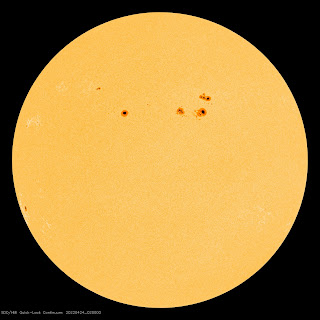Stomping out Solar Misconceptions (Part 1 of a seemingly never-ending series)
Among the supposed apocalyptic scenarios connected with the 2012 hoax was a solar "superflare" toasting our planet. In my research on the topic, I stumbled across many misconceptions concerning our star, leading to an article in the Journal of the American Association of Variable Star Observers. Fast forward one solar cycle later, and I have seen far too many similar claims in the press, as the sun awakens from its normal solar minimum doldrums. A decade older, wiser, and more militant in my understanding of the harm that perpetuating misconceptions can cause (one of the serious drawbacks of the internet age), I am far better prepared for the battle ahead, as we climb towards solar maximum in a few years. In fact, I recently signed a book contract for a work on how the sun is portrayed (badly) in popular media (a great excuse to watch lots of bad sci fi movies and slog through horrendously misleading social media posts). But I can't hope to possibly cover all of the misconceptions in a single work, so I will augment that project with the occasional blog post on specific examples I stumble across during my research.
To kick off this series, I present an article from the British newspaper Independent, entitled "Third solar flare in 48 hours marks an increasingly active sun." Unlike many of the similar articles I have seen online, this title is fairly innocuous and hype-free. The brief article is filled with facts and recent observations, but no end-of-the-world predictions. However, the comments section to the newspaper's Facebook posting of this article is another matter completely.
In the name of preserving my own sanity, I concentrated on merely righting three specific scientific wrongs I found in a single sub-thread. To avoid further embarassing the posters (since my goal is to educate), I will paraphrase the claims and quote my replies. I hope you find this information interesting.
Claim: The last time the sun's activity was as quiet as it was at the previous minimum in 2019 was during the Maunder Minimum (specifically 1745). The poster then makes a claim connecting the freezing over of the Thames River at that time with global warming and solar activity.
My reply: The minimum of 2019 was certainly not the same as the Maunder minimum. Having low numbers of sunspots during solar minimum is not the same as an extended, decades-long, decrease in sunspot activity. As well, the urban legends about a possible connection between the "Frost Fairs" and the Maunder Minimum (as well as the proposed connection to the so-called "Little Ice Age") have pretty much been debunked by peer reviewed articles [for example, see Owens, Mathew J., Mike Lockwood, Ed Hawkins, et al. (2017) “The Maunder Minimum and the Little Ice Age: An Update from Recent Reconstructions and Climate Simulations.” Journal of Space Weather and Space Climate 7: A33 (10 pp); Meehl, Gerald A., Julie M. Arblaster, and Daniel R. Marsh (2013) “Could a Future ‘Grand Solar Minimum’ Like the Maunder Minimum Stop Global Warmth?” Geophysical Research Letters 40: 1789-93; Lockwood, Mike, et al. (2017) "Frost fairs, sunspots and the Little Ice Age." Astronomy and Geophysics 58(2): 2.17-23.]
Claim: We are warmer now because we are closer to the sun than we were in 1745 due to the Milankovitch cycles (which are connected to cycles in ice ages).
My reply: There are 3 aspects to the Milankovitch cycle: the shape of the earth's orbit (the eccentricity), which does slightly impact distance from sun, the inclination of tilt of the earth's axis (which impacts the severity of the seasons), and the precession, the orientation of the axis with the orbit [i.e. is it summer in the northern hemisphere when we are closer to the sun or farther away). It turns out that for earth (NOT for Mars, interestingly) eccentricity (again, which is the only component that impacts our distance from the sun) is the LEAST important component for the Milankovitch cycles. This has been known since at least 1976 [Hays, J.D., et al. (1976) “Variations in the Earth’s Orbit: Pacemaker of the Ice Ages.” Science, 194:1121-32]. Perhaps you are confusing this with an infamous retracted paper which made some claims about our distance from the sun that were shown to be untrue: “Retraction Note: Oscillations of the Baseline of Solar Magnetic Field and Solar Irradiance on a Millennial Timescale” (2020) Scientific Reports 10: 4336 (1 p). https://www.nature.com/articles/s41598-020-61020-3
Claim: We are actually moving farther away from the sun due to the sun losing mass (I assume the poster meant because as it fuses hydrogen into helium to "shine" some mass is converted into light energy - photons - due to Einstein's E = mc2).
My reply: The sun's mass will not appreciably change until it becomes a red giant. Our orbit may, indeed, move away from the sun eventually, which MIGHT prevent us from being literally swallowed by the sun at this point (although our oceans will boil away long before this). Here are some peer reviewed sources for you: Schröder, K.-P., and Robert Connon Smith (2008) “Distant Future of the Sun and Earth Revisited.” Monthly Notices of the Royal Astronomical Society 386: 155-63; Sackmann, I-Juliana et al. (1990) "Our Sun. III. Present and Future." Astrophysical Journal 418: 457-68; This is a non-scholarly summary, which also takes into account some chaotic factors: https://www.forbes.com/.../ask-ethan-will-the-earth.../...
Tune in next time, for the next episode of "how misconceptions make my stomach turn...."



Comments
Post a Comment